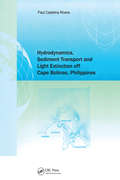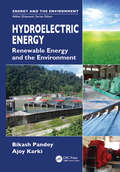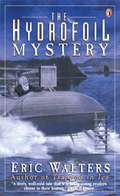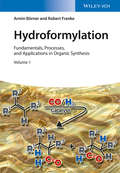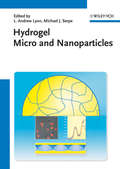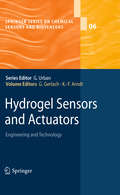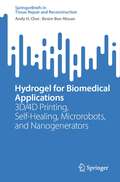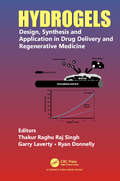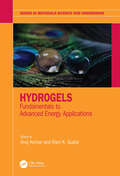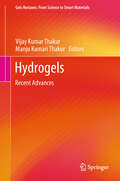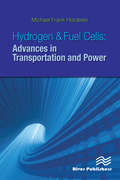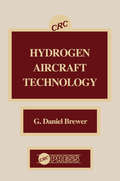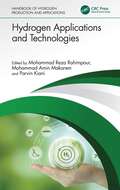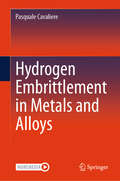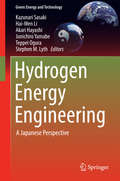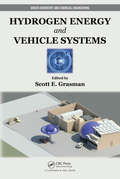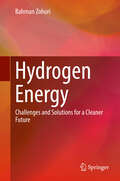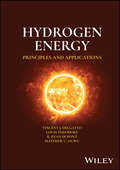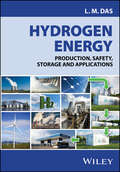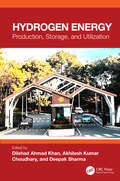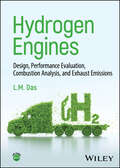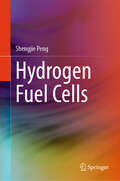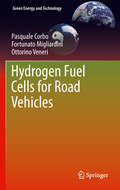- Table View
- List View
Hydrodynamics, Sediment Transport and Light Extinction Off Cape Bolinao, Philippines
by Paul Cadelina RiveraObservational and numerical modelling studies of the hydrodynamics, sediment transport, and light extinction were undertaken in the marine environment around Cape Bolinao in the Lingayen Gulf (NW Philippines). This text reports on the results of these studies, and offers conclusions.
Hydroelectric Energy: Renewable Energy and the Environment
by Bikash Pandey Ajoy KarkiProviding essential theory and useful practical techniques for implementing hydroelectric projects, this book outlines the resources, power generation technologies, applications, and strengths and weaknesses for hydroelectric technologies. Emphasizing the links between energy and the environment, it serves as a useful background resource and facilitates decision-making regarding which renewable energy technology works best for different types of applications and regions. Including examples, real-world case studies, and lessons learned, each chapter contains exercise questions, references, and ample photographs and technical drawings from actual micro hydropower plants.
Hydrofoil Mystery
by Eric WaltersIt is 1915 and thirteen-year old William is sent by his mother to spend the summer working with an eccentric inventor, Alexander Graham Bell, and his crew in a tiny Nova Scotia town. They are hard at work designing and building a hydrofoil boat that they hope will help the Allies defend themselves from the German U-boats that are sinking ships and threatening coastal towns during the war. But the sleeping village life William thinks he has been sentenced to turns out to be something quite different as the young boy finds himself embroiled in a deadly mystery that is plaguing the hydrofoil and its builders.
Hydroformylation
by Armin Börner Robert FrankeFilling a gap in the market for an up-to-date work on the topic, this unique and timely book in 2 volumes is comprehensive in covering the entire range of fundamental and applied aspects of hydroformylation reactions. The two authors are at the forefront of catalysis research, and unite here their expertise in synthetic and applied catalysis, as well as theoretical and analytical chemistry. They provide a detailed account of the catalytic systems employed, catalyst stability and recovery, mechanistic investigations, substrate scope, and technical implementation. Chapters on multiphase hydroformylation procedures, tandem hydroformylations and other industrially applied reactions using syngas and carbon monoxide are also included. The result is a must-have reference not only for synthetic chemists working in both academic and industrial research, but also for theoreticians and analytical chemists.
Hydrogel Micro and Nanoparticles
by Michael Joseph Serpe L. Andrew LyonThe book provides experienced as well as young researchers with a topical view of the vibrant field of soft nanotechnology. In addition to elucidating the underlying concepts and principles that drive continued innovation, major parts of each chapter are devoted to detailed discussions of potential and already realized applications of micro- and nanogel- based materials. Examples of the diverse areas impacted by these materials are biocompatible coatings for implants, films for controlled drug release, self-healing soft materials and responsive hydrogels that react to varying pH conditions, temperature or light.
Hydrogel Sensors and Actuators
by Gerald Gerlach K. F. ArndtHydrogels are a fascinating class of polymers which show an immense ability of swelling under the influence of temperature, pH value or concentrations of different species in aqueous solutions. The volume change can amount up to several hundred percent. This unique behaviour is already used in such applications like disposable diapers, contact lenses or drug-delivery systems. The ability to perform mechanical work has been shifted the technical interest more and more towards sensors and actuators exploiting the thermo-chemo-mechano-electrical coupling within hydrogels. The accuracy requirements for such devices are much more demanding than for previous applications. Therefore, a deep knowledge of both the material and the functional properties of hydrogel sensors and actuators is needed. The monograph describes state of the art and recent developments for these materials in sensor and actuator technology.
Hydrogel for Biomedical Applications: 3D/4D Printing, Self-Healing, Microrobots, and Nanogenerators (Tissue Repair and Reconstruction)
by Besim Ben-Nissan Andy H. ChoiThis book highlights the latest clinical research and advancements in 3D (bio)printing and 4D printing using stimulus-responsive hydrogels as well as the concept of self-healing and its amalgamation with 3D printed injectable cell-laden tissue constructs. It also explores the use of metal-free “click” chemistry and enzymes such as horseradish peroxidase, hematin, tyrosinase, and transglutaminase to obtain chemically crosslinked hydrogels and the in vitro and in vivo responses. Lastly, the book briefly examines the future of drug delivery and the potentials offered by microrobotics and self-powered devices based on triboelectric nanogenerators. This book caters to biomedical researchers and clinical practitioners working in tissue reconstruction and drug/therapeutic delivery.
Hydrogels: Design, Synthesis and Application in Drug Delivery and Regenerative Medicine
by Thakur Raghu Singh Garry Laverty Ryan DonnellyHydrogels are crosslinked, macromolecular polymeric materials arranged in a three-dimensional network, which can absorb and retain large amounts of water. Hydrogels are commonly used in clinical practice and experimental medicine for a wide range of applications, including drug delivery, tissue engineering and regenerative medicine, diagnostics, cellular immobilization, separation of biomolecules or cells, and barrier materials to regulate biological adhesions. This book elucidates the underlying concepts and emerging applications of hydrogels and will provide key case studies and critical analysis of the existing research.
Hydrogels: Fundamentals to Advanced Energy Applications (Series in Materials Science and Engineering)
by Anuj Kumar and Ram K. GuptaThe demand for advanced energy devices such as high-performance batteries, supercapacitors, fuel cells, electrolyzers, and flexible/wearable devices is increasing rapidly. To meet such demand, high-performance and stable materials that could be used as active materials in these devices are much needed. This book focuses on the use of hydrogels in such emerging applications. The main objective of this book is to provide current, state-of-the-art development in hydrogel-based materials, their applications in energy, and their future challenges. This book covers the entire spectrum of hydrogels for their applications in a range of energy devices in terms of materials, various synthetic approaches, architectural aspects, design and technology of energy devices, and challenges. This book covers the fundamentals of hydrogels, various composites of hydrogels, design concepts, different technologies, and applications in the diverse energy area. All chapters are written by experts in these areas around the world, making this a suitable textbook for students and providing new guidelines to researchers and industries working in these areas. This book includes topics such as various approaches to synthesizing hydrogels, their characterizations, and emerging applications in the energy area. Fundamentals of energy devices, working principles, and their challenges are also covered. This book will provide new directions to scientists, researchers, and students to better understand hydrogel-based materials and their emerging applications in energy.
Hydrogels: Recent Advances (Gels Horizons: From Science to Smart Materials)
by Vijay Kumar Thakur Manju Kumari ThakurThis book discusses recent advances in hydrogels, including their generation and applications and presents a compendium of fundamental concepts. It highlights the most important hydrogel materials, including physical hydrogels, chemical hydrogels, and nanohydrogels and explores the development of hydrogel-based novel materials that respond to external stimuli, such as temperature, pressure, pH, light, biochemicals or magnetism, which represent a new class of intelligent materials. With their multiple cooperative functions, hydrogel-based materials exhibit different potential applications ranging from biomedical engineering to water purification systems. This book covers key topics including superabsorbent polymer hydrogel; intelligent hydrogels for drug delivery; hydrogels from catechol-conjugated materials; nanomaterials loaded hydrogel; electrospinning of hydrogels; biopolymers-based hydrogels; injectable hydrogels; interpenetrating-polymer-network hydrogels: radiation- and sonochemical synthesis of micro/nano/macroscopic hydrogels; DNA-based hydrogels; and multifunctional applications of hydrogels. It will prove a valuable resource for researchers working in industry and academia alike.
Hydrogen & Fuel Cells: Advances in Transportation and Power
by Michael Frank HordeskiThe hydrogen car has been proposed as the solution to our oil problems, but how would it work, and what potential problems associated with it? This book addresses these questions and provides specifics about current developments toward a hydrogen-based energy infrastructure. It offers the reader an informed look at the current state of fuel cell power and transportation technology, and where it's headed.
Hydrogen Aircraft Technology
by G.Daniel BrewerLiquid hydrogen is shown to be the ideal fuel for civil transport aircraft, as well as for many types of military aircraft. Hydrogen Aircraft Technology discusses the potential of hydrogen for subsonic, supersonic, and hypersonic applications. Designs with sample configurations of aircraft for all three speed categories are presented, in addition to performance comparisons to equivalent designs for aircraft using conventional kerosine-type fuel and configurations for aircraft using liquid methane fuel. Other topics discussed include conceptual designs of the principal elements of fuel containment systems required for cryogenic fuels, operational elements (e.g., pumps, valves, pressure regulators, heat exchangers, lines and fittings), modifications for turbine engines to maximize the benefit of hydrogen, safety aspects compared to kerosine and methane fueled designs, equipment and facility designs for servicing hydrogen-fueled aircraft, production methods for liquid hydrogen, and the environmental advantages for using liquid hydrogen. The book also presents a plan for conducting the necessary development of technology and introducing hydrogen fuel into the worldwide civil air transport industry. Hydrogen Aircraft Technology will provide fascinating reading for anyone interested in aircraft and hydrogen fuel designs.
Hydrogen Applications and Technologies
by Mohammad Reza Rahimpour Mohammad Amin Makarem Parvin KianiHydrogen has wide applications across many industries, including petroleum refineries, hydrotreating processes, and metallurgy applications. In addition, a number of valuable chemicals, such as ammonia, alcohols, and acids, are manufactured directly or indirectly with hydrogen. Hydrogen Applications and Technologies covers the utilization of hydrogen in petrochemical products, vehicles, and power generation systems, as well as in refinery hydrotreating, metallurgy, welding, annealing, and the heat‑treating of metals. Describes the application of hydrogen in producing valuable chemicals in detail Comprehensively discusses hydrogen utilization as an energy source Covers the application of hydrogen in power generation systems and across various industries Reviews hydrogen’s role as an agent in chemical reactions Part of the multivolume Handbook of Hydrogen Production and Applications, this stand-alone book guides researchers and academics in chemical, environmental, energy, and related areas of engineering interested in development and implementation of hydrogen production technologies.
Hydrogen Assisted Direct Reduction of Iron Oxides
by Pasquale CavaliereThe book describes the main approaches to produce and synthesize iron and steel through hydrogen-based technologies. Depending on the processing route and on the energy demand, the best available techniques and the most forward-looking solutions are explained. The book is edited with the contribution representing a range of industries in order to evaluate the industrial feasibility of each selected technology. It presents the most efficient solutions applied by ironmaking and steelmaking factories all around the world.
Hydrogen Embrittlement in Metals and Alloys
by Pasquale CavaliereThis book provides a complete description of hydrogen technologies from the basic theoretical underpinnings to the different production routes for various applications. It summarizes the most recent research findings with respect to theory and the broad array of industrial technologies currently in place as well as those under development with high potential. Special attention is given to the hydrogen embrittlement mechanisms at room and high temperatures as well as problems related to hydrogen in liquid and high-pressure compressed states. The author further describes the hydrogen diffusion embrittlement issues related to different types of metallic materials from steel to light alloys to nikel-based superalloys.
Hydrogen Energetics: A Future Clean Energy Carrier
by Roman J. PressUnderstand the future of clean energy with this timely introduction Hydrogen is a clean fuel that can be used to power fuel cells whose only biproduct is water. This flexible energy carrier can be produced from a range of natural processes and domestic energy resources, and it has potentially widespread applications. In an era defined by global climate change and the search for sustainable energy, hydrogen energetics is a field with transformative potential. Hydrogen Energetics provides a cutting-edge introduction to current research and applications in this vital field. It offers an overview of hydrogen energy usage, including both positives and negatives, with a particular emphasis on the economic and infrastructural dimensions. Its up-to-date view of the state of the field and balance of theoretical and practical knowledge make it an essential resource. Hydrogen Energetics readers will also find: A one-stop resource for understanding the scientific foundations, applications, and environmental impacts of hydrogen utilization Detailed discussion of topics including hydrogen properties, hydrogen production, and key characteristics of fuel cells A focus on both technical and economic aspects of hydrogen energetics Hydrogen Energetics is a valuable source for researchers and academics in any field connected to renewable energies, energy storage, and environmental science, as well as for any professionals working with sustainability and natural resource availability.
Hydrogen Energy Engineering
by Kazunari Sasaki Hai-Wen Li Akari Hayashi Junichiro Yamabe Teppei Ogura Stephen M. LythThis book focuses on the fundamental principles and latest research findings in hydrogen energy fields including: hydrogen production, hydrogen storage, fuel cells, hydrogen safety, economics, and the impact on society. Further, the book introduces the latest development trends in practical applications, especially in commercial household fuel cells and commercial fuel cell vehicles in Japan. This book not only helps readers to further their basic knowledge, but also presents the state of the art of hydrogen-energy-related research and development. This work serves as an excellent reference for beginners such as graduate students, as well as a handbook and systematic summary of entire hydrogen-energy systems for scientists and engineers.
Hydrogen Energy and Vehicle Systems (Green Chemistry and Chemical Engineering)
by Scott E. GrasmanWith contributions from noted laboratory scientists, professors, and engineers, Hydrogen Energy and Vehicle Systems presents a new comprehensive approach for applying hydrogen-based technologies to the transportation and electric power generation sectors. It shows how these technologies can improve the efficiency and reliability of energy and trans
Hydrogen Energy: Challenges and Solutions for a Cleaner Future
by Bahman ZohuriThis book describes the challenges and solutions the energy sector faces by shifting towards a hydrogen based fuel economy. The most current and up-to-date efforts of countries and leaders in the automotive sector are reviewed as they strive to develop technology and find solutions to production, storage, and distribution challenges. Hydrogen fuel is a zero-emission fuel when burned with oxygen and is often used with electrochemical cells, or combustion in internal engines, to power vehicles and electric devices. This book offers unique solutions to integrating renewable sources of energy like wind or solar power into the production of hydrogen fuel, making it a cost effective, efficient and truly renewable alternative fuel.
Hydrogen Energy: Principles and Applications
by Louis Theodore R. Ryan Dupont Vincent J. DelGatto Matthew C. OgwuUnderstand hydrogen as an energy resource and its potential as a dynamic solution for a carbon-neutral economy Hydrogen is an energy carrier that can be used to store, move, and deliver energy produced from other sources. It has the potential for high energy efficiency, significant environmental and social benefits, and economic competitiveness. Traditional energy resources will not be able to meet the growing energy demand, despite the advances in energy management and energy conservation—understanding how hydrogen energy can solve this problem is crucial. Hydrogen Energy: Principles and Applications provides the information needed by energy resource planners, scientists, engineers, and government officials to make informed energy-related decisions. Divided into three parts, the book opens with an introduction to various energy issues, sources, and regulations, including the basics of thermodynamics and fuel cells. The second part addresses the practical aspects of hydrogen energy, such as availability, distribution, extraction, processing, purification, transportation, transmission, and storage. The final section details the economics, energy-environmental interactions, and ethical and political considerations of the development and use of hydrogen energy, including discussion of investment and business contacts, energy option analysis and optimization, and future prospects. Covering the fundamentals of hydrogen energy with a thorough and accessible approach, the book: Equips readers with a well-rounded working knowledge of hydrogen energy Covers the latest technological advances, economic considerations, and the role hydrogen plays in a renewable energy economy Offers a pragmatic, real-world perspective rather than focusing on theoretical issues Contains nearly 50 illustrative examples ranging from elementary thermodynamic calculations to optimization applications using linear programming Hydrogen Energy: Principles and Applications is a must-read for those working in the energy industry, particularly environmental engineering and science professionals, as well as government officials, policymakers, instructors, and trainers involved in energy-related fields.
Hydrogen Energy: Production, Safety, Storage and Applications
by Lalit Mohan DasHYDROGEN ENERGY Comprehensive resource exploring integrated hydrogen technology with guidance for developing practical operating systems Hydrogen Energy presents all-inclusive knowledge on hydrogen production and storage to enable readers to design guidelines for its production, storage, and applications, addressing the recent renewed interest in hydrogen energy to manage the global energy crisis and discussing the electrochemical potential of hydrogen in transportation and fuel cells. Written by a highly qualified author, Hydrogen Energy explores sample topics such as: Essentials of hydrogen energy, such as its occurrence, physico-chemical properties, production, transmission, delivery, storage, and utilization Technology of hydrogen utilization in the land transport sector, such as automobiles, as well as other modes of transport, like marine and air Combustion characteristics and environmental pollution features, internal combustion engines, and fuel cells Guidelines to design prototype systems, covering their safety, hydrogen induced damages and life cycle analysis Providing in-depth coverage of the subject, Hydrogen Energy is an ideal resource for researchers and professionals working towards developing time-bound goal-oriented hydrogen-based programs in the chemical, automobile, power, and process engineering sectors.
Hydrogen Energy: Production, Storage and Utilization
by Dilshad Ahmad Khan, Akhilesh Kumar Choudhary, and Deepak SharmaSince the low energy efficiency and rise in emissions by using fossil fuels, the hydrogen economy has been considered as a unique approach to resolve these problems, making hydrogen an attractive fuel. This book titled Hydrogen Energy: Production, Storage, and Utilization describes various technologies for hydrogen production from different sources and storage in liquid, gaseous, and compound forms, which have also been covered in detail. It also highlights the various modes of transportation of hydrogen and its utilization in a variety of engineering applications such as automotive engines, fuel cells, electric power generation, and aerospace. The book also explores the safety challenges, handling issues, and future scope.This book: Covers the methods of hydrogen production including the bioconversion method. Explains the hydrogen storage technologies with proper illustrations. Includes engineering and non-engineering applications of hydrogen utilization covering the most advanced generation of fuel cells, power generation for hybrid vehicles, and space applications. Presents state-of-the-art research carried out in the domains of hydrogen production, storage, transportation, and utilization along with safety aspects. Discusses modes and methods of hydrogen transportation such as in gaseous form, liquid form, and solid form. The book has a wide scope of reaching out to diverse readers including but not limited to industrial engineers, process engineers, researchers, and academicians. The research fraternity will gain the benefit of being aware and selecting a similar recent research domain in the field of hydrogen production.
Hydrogen Engines: Design, Performance Evaluation, Combustion Analysis, and Exhaust Emissions
by Lalit Mohan DasA comprehensive and authoritative resource for the development of hydrogen-specific internal combustion engines Hydrogen Engines: Design, Performance Evaluation, Combustion Analysis, and Exhaust Emissions, authored by Dr. Lalit Mohan Das, a seasoned alternative fuels researcher, offers an in-depth technical description of hydrogen as a fuel, presenting a balanced analysis of hydrogen’s advantages and challenges. The book covers hydrogen’s performance, emissions, combustion, and safety aspects for both spark ignition (SI) engines and compression ignition (CI) engines. A comprehensive source of information on the design requirements for hydrogen-specific engines, the book compiles the technical guidelines typically found only in research papers scattered amongst the scientific literature. In Hydrogen Engines, readers will find: A thorough consideration of the distinctive properties of hydrogen, such as minimum ignition energy, flammability limit, and flame speed, and their influence on undesirable combustion phenomena, such as pre-ignition, backfire, and knocking Comprehensive explorations of the modes of utilization of hydrogen in internal combustion engines, neat hydrogen engines, dual fuel, and hydrogen in blends with other fuels, such as CNG, LPG, Alcohols, Biogas, Biodiesel, DME producer gas, etc. Upgraded strategies such as supercharging, turbocharging, stratification, HCCI, RCCI, and rotary engine configuration using hydrogen fuel Applications of laser diagnostics and other sensing techniques NOx formation and exhaust emission control, lean engine operations, and exhaust gas recirculation A detailed description of how to mitigate hydrogen’s challenges to develop efficient, low-emission engines and prototype real-world vehicles Invaluable for researchers in academia and government labs, the book will also benefit policymakers and engineers working in research and development within the automotive and transportation industries.
Hydrogen Fuel Cells
by Shengjie PengThis book introduces in detail the different types of hydrogen fuel cells, including alkaline fuel cells, proton exchange membrane fuel cells, solid oxide fuel cells, phosphate fuel cells, molten carbonate fuel cells, direct liquid fuel cells, etc., and discusses their operating principles, performance characteristics and application fields in depth. Readers will be able to comprehensively understand the current status and future development trends of fuel cell technology to provide technical support for hydrogen energy applications. The last two chapters of the book also introduce the automotive application and development of alkaline fuel cells, and the application of hydrogen-powered transportation equipment in the field of national defense. This book is not only suitable as a teaching material or teaching reference book for senior undergraduate and graduate students of relevant majors in colleges and universities, but also suitable for scientific and technological workers engaged in scientific research and technology research and development of new energy materials and devices and related fields.
Hydrogen Fuel Cells for Road Vehicles
by Pasquale Corbo Fortunato Migliardini Ottorino VeneriHydrogen Fuel Cells for Road Vehicles addresses the main issues related to the application of hydrogen fuel cell technology in the road transportation sector. A preliminary treatment is given on fuel resources and atmospheric pollution concerns which are closely related to the current technology (internal combustion engine) used for moving people and goods. The authors deal, in particular, with the problems that can hinder a widespread hydrogen market (production, storage and distribution), as well as giving an analysis of fuel cell technologies available for utilization of this energy carrier in the automotive field. Hydrogen Fuel Cells for Road Vehicles also examines the concerns faced during the design and realization of a PEM fuel cell system with optimal size and efficiency, evidencing the impact of the individual auxiliary components on energy losses and dynamic stack performance. The book ends with the analysis of two practical case studies on fuel cell propulsion systems. Hydrogen Fuel Cells for Road Vehicles is a useful text for researchers, professionals and advanced students in the fields of automotive and environmental engineering.
